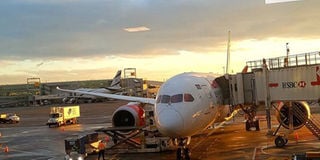Lessons in timely decision from historic KQ flight to New York

Kenya Airways plane pictured at the John F. Kennedy International Airport in New York, the United States after landing on October 29, 2018. PHOTO | COURTESY
What you need to know:
The direct flight cuts travel time between Kenya and the US by over 10 hours, improving prospects for increased earnings from tourists and business travellers from the American market.
The US, with a population of over 325 million with average incomes of over $60,000 (Sh6 million) a year, is one of the largest source markets for Kenya’s tourism.
When Kenya Airways’ inaugural direct flight to the United States finally took off on Sunday night, the fanfare around the historic moment masked the turbulence of how long it has taken to get the rights to fly non-stop to American airports.
It’d taken the government more than a decade to comply with the strict US aviation requirements for direct flights between Jomo Kenyatta International Airport and John F. Kennedy in New York.
OPPORTUNITIES
The envisaged benefits from the daily flight connections — from increased revenue for KQ to expanded trade, investment and tourism opportunities — would have contributed to Kenya’s economic and social transformation much earlier. Bureaucracy and regional security threats from Al-Shabaab delayed these benefits.
Plans for the direct aviation connectivity were part of the Northern Corridor Transport Improvement Project that former President Mwai Kibaki’s government implemented from September 2004 with the support of the World Bank.
CATEGORY ONE
One of the components of the project was to enhance Kenya’s aviation safety and security to meet international standards. That involved improving the operations of the Kenya Civil Aviation Authority to achieve Category One status clearance under the International Aviation Safety Assessment of the US Federal Aviation Administration. The project also financed the upgrading of JKIA to have it cleared by the US Transport and Security Administration.
MAJOR SETBACK
Actions required to improve security included separating domestic and international flight facilities and arrivals and departures. The option was to move the domestic flights terminal to the old Embakasi airport but the idea was abandoned even after implementation of a contract to improve the facility. Some of the duty-free shops, which had turned JKIA into a bazaar, were also supposed to be removed.
Although TSA cleared JKIA for direct flights in April 2009, safety and security clearances were not obtained, mainly due to terrorism threats. Kenya also suffered a major setback when a fire destroyed part of the airport’s main terminal building in August 2013. The clearance was finally obtained this year, in what has turned out to be an important pointer to warmer relations between President Uhuru Kenyatta’s government and US President Donald Trump’s administration.
HASTEN RECOVERY
The flights open a world of opportunities that need to be managed for Kenya to maximise the benefits. KQ anticipates a revenue increase of 10 percent, according to Sebastian Mikosz, its CEO. An additional income of over Sh10 billion (10 percent of its 2017 revenue of Sh106 billion) would hasten KQ’s recovery from three years of losses that forced it into a government bailout last year. The national carrier has to remain competitive.
SOURCE MARKETS
The direct flight cuts travel time between Kenya and the US by over 10 hours, improving prospects for increased earnings from tourists and business travellers from the American market. The US, with a population of over 325 million with average incomes of over $60,000 (Sh6 million) a year, is one of the largest source markets for Kenya’s tourism.
The greatest benefit for Kenya would be in trade and investment, driven by improved competitiveness and the readiness of exporters to venture into the US market with quality products. Reducing the cost of doing business and improving the quality of textiles and garments, for instance, would be critical to expand trade under the Africa Growth and Opportunity Act (Agoa).
REGIONAL HUBS
The government also needs to manage the improving interest of large US firms keen to establish regional hubs in Kenya. They need a conducive environment for doing business, hence, the need for prudent business regulations and fighting illegal trade practices.
The latest “Doing Business” indicators show the shortfalls, whose fixing would save the economy from losses caused by bureaucracy and apathy in making and enforcing good business practices.
Mr Warutere is a director of Mashariki Communications Ltd. [email protected].





